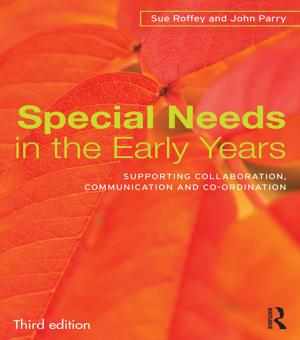Alzheimer Discourse
Some Sociolinguistic Dimensions
Nonfiction, Reference & Language, Language Arts, Communication| Author: | Vai Ramanathan | ISBN: | 9781136685729 |
| Publisher: | Taylor and Francis | Publication: | November 5, 2013 |
| Imprint: | Routledge | Language: | English |
| Author: | Vai Ramanathan |
| ISBN: | 9781136685729 |
| Publisher: | Taylor and Francis |
| Publication: | November 5, 2013 |
| Imprint: | Routledge |
| Language: | English |
This book deals with the narrative discourse--specifically lifestories--of 16 patients suffering from Alzheimer's disease (AD). It attempts to understand the discourse of these patients in contextual terms. Thus far, the dominant explanation for "incoherence" in AD speech has been largely provided by research in psycholinguistics, much of which has understood AD speech in terms of the progressively deteriorating nature of the disease. This study provides a complementary view by examining ways in which some social factors--audiences, setting, and time--influence the extensiveness and meaningfulness of AD talk.
By offering both an examination of interactions across the data as well as analyzing particular cases in detail, this unusual study attempts to juxtapose some general insights regarding AD discourse with case-specific ones. Sociolinguistic analyses of the data demonstrate how certain audiences and particular settings set in motion discourse activities that either facilitate the patients' ability to recall their pasts or impede it. This analysis also includes a critical look at the researcher's contribution in negotiating and reinforcing these activities. Ethnographic details about the social worlds of some of these patients shed light on how larger social contexts at least indirectly contribute to exacerbating the patients' conditions or stabilizing them. The analyses of both context and language provides a more global understanding of the Alzheimer experience. This study also discusses some interactional strategies by which professionals can begin to engage AD patients in meaningful talk as well as ways by which they can better "hear" AD patients' cues at narrating. Throughout, this book underscores the need to factor in social factors when making assessments regarding AD patients' communicative abilities.
This book deals with the narrative discourse--specifically lifestories--of 16 patients suffering from Alzheimer's disease (AD). It attempts to understand the discourse of these patients in contextual terms. Thus far, the dominant explanation for "incoherence" in AD speech has been largely provided by research in psycholinguistics, much of which has understood AD speech in terms of the progressively deteriorating nature of the disease. This study provides a complementary view by examining ways in which some social factors--audiences, setting, and time--influence the extensiveness and meaningfulness of AD talk.
By offering both an examination of interactions across the data as well as analyzing particular cases in detail, this unusual study attempts to juxtapose some general insights regarding AD discourse with case-specific ones. Sociolinguistic analyses of the data demonstrate how certain audiences and particular settings set in motion discourse activities that either facilitate the patients' ability to recall their pasts or impede it. This analysis also includes a critical look at the researcher's contribution in negotiating and reinforcing these activities. Ethnographic details about the social worlds of some of these patients shed light on how larger social contexts at least indirectly contribute to exacerbating the patients' conditions or stabilizing them. The analyses of both context and language provides a more global understanding of the Alzheimer experience. This study also discusses some interactional strategies by which professionals can begin to engage AD patients in meaningful talk as well as ways by which they can better "hear" AD patients' cues at narrating. Throughout, this book underscores the need to factor in social factors when making assessments regarding AD patients' communicative abilities.















